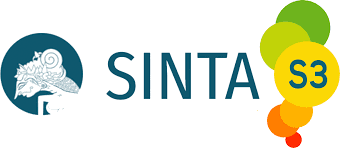Persepsi Generasi Y Terhadap Pilihan Karier di Perusahaan Publik
DOI:
https://doi.org/10.24002/modus.v28i1.666Abstract
Abstrak
Penelitian ini bertujuan untuk mengetahui perbedaan persepsi dari generasi Y terhadap pilihan karier di perusahaan publik. Selain itu juga untuk mengetahui apakah gender mempengaruhi perbedaan persepsi dari generasi Y terhadap pilihan karier di perusahaan publik. Dalam era globalisasi dan era liberalisasi seperti sekarang ini, pengambilan keputusan karier bukanlah keinginan sesaat semata. Penentuan tersebut harus didasarkan pada kemampuan dan pemahaman diri mereka sendiri. Oleh karena itu gender juga menjadi salah satu hal yang juga mempengaruhi dalam proses perekrutan sektor publik. Laki-laki memilih bidang karier tertentu berdasarkan bidang orang tua dan belum memiliki pandangan akan masa depannya. Sedangkan di satu sisi, perempuan mereka lebih menghadapi kesulitan dalam menghadapi keputusan pemilihan karier karena keterbatasan bidang dan juga lingkungan yang masih tradisional.
Berdasarkan hasil analisis data yang telah dilakukan dapat disimpulkan bahwa terdapat perbedaan persepsi antara laki-laki dan perempuan, akan tetapi tidak terdapat perbedaan faktor yang mempengaruhi pilihan karier di perusahaan publik.
Kata kunci: Generasi Y, Perekrutan, Persepsi, Perusahaan Publik, Pilihan Karier.
Abstract
This study aims to determine differences in the perception of the Y generation on career options in public companies. It is also to find out whether gender affects the differences in the perception of the Y generation on career options in public companies. In the era of globalization and liberalization, as now, the career decision making is not merely a whim. The determination should be based on ability and understanding of themselves. Therefore, gender is also becoming one of the things that also affect the public sector hiring process. Men choose a particular career field by their parent’s career field and do not have a view about the future. While on the one hand, they are more women face difficulties in dealing with career choice decision because of limited fields and the environment is still traditional.
Based on the results of data analysis can be concluded that there is a difference in perception between men and women, but there are differences in factors that affect career options in public companies.
Keywords: Career Options, Generation Y, Perception, Public Company, Recruitment.
References
Anggriana, T.M. (2009). Hubungan Locus Of Control dan Persepsi Peran Jenis Kelamin dengan Keputusan Pemilihan Karir Siswa Kelas X SMA Negeri 6 Semarang. Jurnal Psikologi.
.
Aprilyan, L.A. dan Laksito. H. (2015). Analisis Faktor-Faktor yang Mempengaruhi Kinerja Pegawai Dalam Organisasi Sektor Publik. Diakses dari http://eprints.undip.ac.id/26837/pada 14 September 2015.
Ballenstedt, B. dan Rosenberg, A. (2008). De-Generation. Government Executive No. 40 (8): 18-23.
Bassett, B. (2008). Working With Generation Y. Office Pro 68 (2): 16-19.
Badriah, M. (2015). Manajemen Sumber Daya Manusia. Bandung: Pustaka Setia.
Benson, J., dan Brown, M. (2011). Generations at work: Are there differences and do the matter?. The International Journal of Human Resource Management, 22 (9): 1843-1865.
Blain, A. (2008). The Millennial Tidal Wave: Five Elements That Will Change TheWorkplace of Tomorrow. Journal of the Quality Assurance Institute (22) 2: 11-13.
Bright, L. (2008). Does Public Service Motivation Really Make a Difference on the Job Satisfaction and Turnover Intentions of Public Employees?. The American Review of Public Administration No. 38 (2): 149-166.
Brown, et.al. (2008). Generation Y in The Workplace. Journal of HR management. The Bush School Texas University.
BSG Concours. (2007). Engaging Today’s Young Employees. Results Research Project YE.
Buahene, A.K. and Kovary, G. (2003). The Road to Performance Success: Understanding and Managing the Generational Divide. Toronto: n-gen People Performance Inc.
Cole, Gene, Richard Smith, dan Laurie Lucas. (2002). The Debut of Generation Y in the American Workforce. Journal of Business Administration Online 1 (2).
Cruz, C.S. (2007). Gen Y: How Boomer Babies are Changing the Workplace. Hawaii Business 52 (11): 38.
Erickson, T.J. (2008). Plugged In The Generation Y Guide to Thriving at Work. Harvard Business Press: Boston, MA.
Farid M, Indiana dan Suranta, Sri. (2006). Persepsi Akuntan, Mahasiswa Akuntansi, dan Karyawan Bagian Akuntansi Dipandang dari Segi Gender Terhadap Etika Bisnis dan Etika Profesi. Simposium Nasional Akuntansi (SNA) IX. Padang, 23-26 Agustus.
Felix, S. (2007). A Flexible Workplace. Benefits Canada No. 31 (6): 16-20.
Gordo, Blanca. (2003). Overcoming Digital Deprivation. IT & Society No. 1 (5): 166-180.
Hariyani, Iswi (2010). Buku Pintar Hukum Bisnis Pasar Modal: Strategi Tepat Investasi Saham, Obligasi, Waran, Right, Opsi, Reksadana, & Produk Pasar Modal Syariah. Jakarta: Visimedia.
Howe, N. Dan Strauss, W. (2007). The Next 20 Years: How Customer and Workforce Attitudes Will Envolve. Harvard Business Review, July-August 2007: 41-52.
Kearney, R.C. (2003). Determinants of State Employee Compensation. Review of Public Personnel Administration 23 (4): 305-322.
Kristof, A.L. (1996). Person Organization Fit: An Integrative Review of its Conceptualizations, Measurement, Implications. Personnel Psychology 49 (1): 1-49.
Kupperschmidt, B. R. (2000). Multigenerational employees: Strategies for effective management. The Health Care Manager, 19: 65–76.
Lloyd, J. (2007). The Truth About Gen Y. Marketing Magazine 112 (19): 12-22.
Perry. J.L. (1996). Measuring Public Service Motivation: An Assessment of Construct Reliability and Validity. Journal of Public Administration Research and Theory: J-PART, Vol. 6, No. 1. January: 5-22.
Pooley, E. (2005). Kids These Days. Canadian Business 78 (12).
Rahayu, S. dkk. (2003). Persepsi Mahasiswa Akuntansi Mengenai Faktor-faktor yang Mempengaruhi Pemilihan Karir. Simposium Nasional Akuntansi VI, Surabaya, 16-17 Oktober.
Santosa, P.B. (2005). Analisis Statistik dengan Microsoft Excel & SPSS. Yogyakarta: ANDI.
Setiyono, B. (2014). Pemerintahan dan Manajemen Sektor Publik. Semarang: CAPS.
Simamora, H. (2001). Manajemen Sumber Daya Manusia, Edisi 2, Cetakan 3. Jakarta: Indeks.
Spiro, C. (2006). Generation Y in the Workplace. Defense AT&L. November-December.
Sugiyono. (2012). Metode Penelitian Bisnis. Bandung: Alfabeta.
Wilson, J dan Musnick, M. (1998). The Contribution of Social Resources to Volunteering. Social Science Quarterly 79 (4): 799-814.














